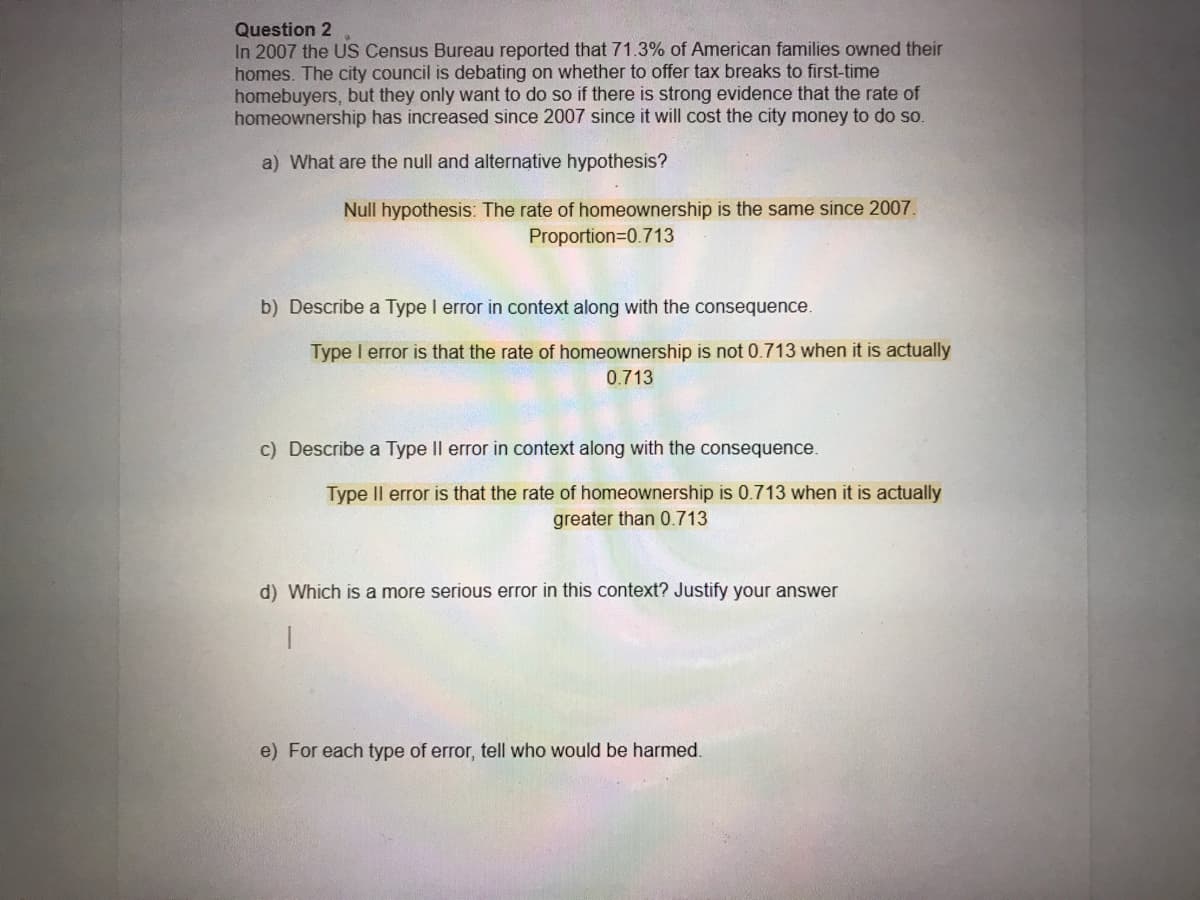Question 2 In 2007 the US Census Bureau reported that 71.3% of American families owned their homes. The city council is debating on whether to offer tax breaks to first-time homebuyers, but they only want to do so if there is strong evidence that the rate of homeownership has increased since 2007 since it will cost the city money to do so. a) What are the null and alternative hypothesis? Null hypothesis: The rate of homeownership is the same since 2007. Proportion=0.713 b) Describe a Type I error in context along with the consequence. Type I error is that the rate of homeownership is not 0.713 when it is actually 0.713 c) Describe a Type II error in context along with the consequence. Type Il error is that the rate of homeownership is 0.713 when it is actually greater than 0.713 d) Which is a more serious error in this context? Justify your answer e) For each type of error, tell who would be harmed.
Question 2 In 2007 the US Census Bureau reported that 71.3% of American families owned their homes. The city council is debating on whether to offer tax breaks to first-time homebuyers, but they only want to do so if there is strong evidence that the rate of homeownership has increased since 2007 since it will cost the city money to do so. a) What are the null and alternative hypothesis? Null hypothesis: The rate of homeownership is the same since 2007. Proportion=0.713 b) Describe a Type I error in context along with the consequence. Type I error is that the rate of homeownership is not 0.713 when it is actually 0.713 c) Describe a Type II error in context along with the consequence. Type Il error is that the rate of homeownership is 0.713 when it is actually greater than 0.713 d) Which is a more serious error in this context? Justify your answer e) For each type of error, tell who would be harmed.
Glencoe Algebra 1, Student Edition, 9780079039897, 0079039898, 2018
18th Edition
ISBN:9780079039897
Author:Carter
Publisher:Carter
Chapter10: Statistics
Section10.1: Measures Of Center
Problem 9PPS
Related questions
Question
100%
I need help with questions D&E

Transcribed Image Text:Question 2
In 2007 the US Census Bureau reported that 71.3% of American families owned their
homes. The city council is debating on whether to offer tax breaks to first-time
homebuyers, but they only want to do so if there is strong evidence that the rate of
homeownership has increased since 2007 since it will cost the city money to do so.
a) What are the null and alternative hypothesis?
Null hypothesis: The rate of homeownership is the same since 2007.
Proportion=D0.713
b) Describe a Type I error in context along with the consequence.
Type I error is that the rate of homeownership is not 0.713 when it is actually
0.713
c) Describe a Type Il error in context along with the consequence.
Type Il error is that the rate of homeownership is 0.713 when it is actually
greater than 0.713
d) Which is a more serious error in this context? Justify your answer
e) For each type of error, tell who would be harmed.
Expert Solution
This question has been solved!
Explore an expertly crafted, step-by-step solution for a thorough understanding of key concepts.
This is a popular solution!
Trending now
This is a popular solution!
Step by step
Solved in 2 steps

Recommended textbooks for you

Glencoe Algebra 1, Student Edition, 9780079039897…
Algebra
ISBN:
9780079039897
Author:
Carter
Publisher:
McGraw Hill

Trigonometry (MindTap Course List)
Trigonometry
ISBN:
9781337278461
Author:
Ron Larson
Publisher:
Cengage Learning

Glencoe Algebra 1, Student Edition, 9780079039897…
Algebra
ISBN:
9780079039897
Author:
Carter
Publisher:
McGraw Hill

Trigonometry (MindTap Course List)
Trigonometry
ISBN:
9781337278461
Author:
Ron Larson
Publisher:
Cengage Learning